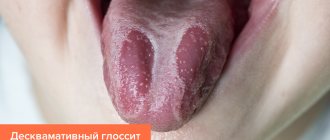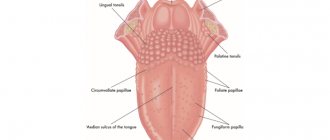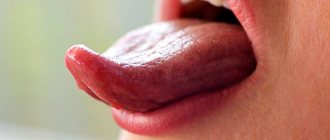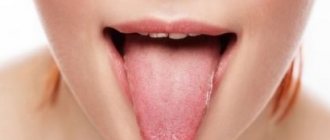What is glossitis?
What do we know about the tongue as an organ? We know that it is located in the mouth, which helps us articulate and pronounce words correctly, helps us mix food, feel all the diversity of existing tastes, that they can be shown indignation, and in some African countries, a demonstration of it can be used to declare war.
Such a significant number of different physiological and social functions may one day be compromised. And the name of this threat is glossitis.
Despite the absolutely clear location of this organ, there are big questions about which doctor deals with its problems: a dentist, gastroenterologist, maxillofacial surgeon or otolaryngologist. This is not an easy question, and sometimes you can endlessly go from one specialist to another. But let's finally understand this intriguing matter.
Forms and types of disease
Inflammation of our organ of taste occurs frequently and does not always manifest itself with symptoms, proceeding completely hidden from us.
There are several forms and types of the disease:
- According to the duration, the disease is divided into acute (develops quickly and lasts no more than a month) or chronic glossitis (lasts more than a month);
- According to the form of the lesion, the catarrhal form (proceeding with redness and swelling) and the desquamative form (proceeding with a change in appearance) are distinguished;
- purulent forms - phlegmon and abscess (a purulent focus in the thickness of the organ tissue itself);
- a separate group includes neurological diseases of the nerves innervating this organ.
Cellulitis and abscess occur acutely, they are associated with infection and require urgent surgical intervention. They manifest themselves as severe pain, chills and swelling of the lymph nodes of the neck - this form can be confused with acute inflammation of the salivary glands, so diagnosis using ultrasound and x-rays is needed. It is better not to delay these symptoms and seek medical help as an emergency.
The catarrhal form of glossitis manifests itself with a sharp blood supply - the tongue swells, becomes bright red - this can manifest itself, for example, with scarlet fever, or an allergic reaction, which, in addition to the organ of taste itself, spreads to the soft palate with the tongue. Treatment in this case is aimed at eliminating the allergic reaction and inflammation.
The largest and most heterogeneous group is desquamative glossitis. It is difficult to list the number of factors (external, internal) that can provoke this form of the disease. We will not make a mistake if we say that “the tongue is the mirror of the digestive tract.” Since it contains many nerve receptors and papillae of different shapes and purposes (filamentous, cone-shaped, mushroom-shaped, leaf-shaped, groove-shaped), a change in each link of its anatomy outwardly reveals a hidden disease. Let's take a little look at the most common diagnostic signs of these conditions.
Causes
One hundred percent causes of this disease have not been identified. And first you need to find out what type of disease we are talking about. If this is the primary type, then the factors are usually external. If secondary - internal, associated with pathologies and diseases of internal organs.
Given the diversity of situations, there are many potential causes of desquamative glossitis, for example:
- tongue injuries due to burns, dentures, teething, etc.;
- chronic diseases of the gastrointestinal tract, gall and liver;
- violation of vitamin and mineral metabolism. For example, when the body lacks vitamins B3, B6 or B1, folic acid, iron, etc.;
- diseases of the hematopoietic system;
- endocrine changes, including during pregnancy;
- autoimmune diseases: rheumatism, lupus, systemic scleroderma;
- chronic dermatoses - the same as psoriasis;
- acute infections: from influenza to typhoid fever;
- helminthic infestations;
- drug intoxication. It can occur due to improper or uncontrolled use of antibiotics and other medications;
- heredity.
It is obvious that with such a variety of causes of desquamative glossitis, effective treatment begins with a thorough diagnosis. First, the doctor needs to rule out a huge number of diseases - and only after that it will become clear how to act.
Changes in appearance depending on the disease
One of the common types is “geographical tongue,” in which its upper surface resembles a map with the borders of countries and continents. This is the most common form of glossitis, which does not manifest itself in any way and does not require medical intervention unless complications arise (numbness, burning). This form occurs in waves, provoked by rough or spicy food, and hormonal cyclic changes. But the loss of the pattern of the papillae may indicate the presence of hypo- or hyperacid gastritis (that is, with increased or decreased acidity of gastric secretions) - such symptoms are typical for patients with gastroesophageal reflux, when hydrochloric acid and bile are thrown from the stomach into the oral cavity.
"Geographical language"
The second most common type of glossitis is a folded tongue. This is an independent type of glossitis. In this case, the back of the tongue seems to be riddled with deep cracks and it feels like there are folds in it. This form of glossitis sometimes accompanies neurological diseases (for example, Melkerson-Rosenthal syndrome) and is present in people with acromegaly (hormone-active pituitary tumor).
"Folded tongue"
Also characteristic are manifestations of various anemias, which are reflected in the appearance of the organ: iron deficiency anemia can manifest itself as a burning sensation on the tip of the tongue, the appearance of cracks on it and an erased pattern of taste buds. Pernicious anemia (B12 deficiency), in which the tongue has a “varnished” appearance with a smooth, swollen surface, sometimes quite painful, with burning symptoms, is the main cause of Gunther-Miller glossitis.
"Lacquered Tongue"
A large group of pathological conditions of this organ are ENT-associated symptoms associated with chronic tonsillitis - here the symptoms are non-specific, ranging from a dirty coating on the tongue to manifestations of diphtheria with white masses that are difficult to remove.
They also distinguish the formation of ulcers on the tongue - aphthous glossitis, which, as a rule, has a viral cause and goes away on its own. This is a recurrent disease, with more frequent episodes it is necessary to exclude pathology of the immune system.
When visiting a doctor, you will often notice pronounced teeth marks on the side of the tongue - a sign of long-term swelling. This occurs in patients with enterocolitis, kidney disease and cardiovascular diseases. The reason for this condition is water retention in the body.
Imprints from teeth on the lateral surface of the tongue
In the presence of abundant white plaque, accompanied by pronounced redness of the oral mucosa, one should suspect a fungal infection, often of a candidal nature. In this case, HIV must be excluded. Also with HIV, “hairy leukoplakia” occurs, when the tongue appears to have white hairs on the side surface, similar to flames - this condition is specific to HIV.
"White Hairy Tongue"
It is worth noting the existence of a “black hairy tongue”, which is a symptom of gastrointestinal disorders, less commonly a fungus.
"Black Hairy Tongue"
As you can see, our organ of taste reflects deep processes in the body, and it is difficult to single out one specialist responsible for its treatment. It is worth involving doctors of different spectrum in therapy, conducting studies based on data from smears and blood tests. But what general recommendations can we, as doctors, give to patients?
Clinical manifestations
Patients note swelling of the organ and an uncharacteristic crimson tint due to the translucency of the vascular network.
The tip and edges of the tongue may become covered with cracks and other erosive lesions. There may be pain and a burning sensation in the inflamed tissues. Unpleasant sensations become more intense when eating. Dry mouth appears, gums begin to bleed. High risk of developing stomatitis.
Depending on the cause that triggered the development of the disease, the patient may experience symptoms:
- With anemia: the skin becomes lemon-colored, gastrointestinal dysfunction and weight loss occur. The patient experiences nausea, numbness of the limbs, and increased fatigue. The long course of the disease leads to visual impairment, hearing impairment, central nervous system disorders, and dementia in people over 60 years of age.
- With pellagra: dermatitis develops on the skin, dementia, diarrhea, and stomatitis appears on the lining of the oral cavity. The person feels lethargic and sleeps poorly.
- With sprue: gastrointestinal manifestations, nausea, weakness, stomatitis. If left untreated, B12 deficiency occurs.
Diagnostic features
When the first manifestations of an anomaly occur, you must come for a consultation to a dental clinic. The dentist will determine the disease based on the patient’s complaints and clinical symptoms. A differential diagnosis is required with stomatitis provoked by contact with an allergen and acute atrophic candidiasis. The dentist is faced with the task of determining the cause of the anomaly and selecting therapy for the original disease.
Laboratory tests are performed. Sometimes consultation with highly specialized specialists is required.
Treatment of the disease
For this anomaly, complex treatment is prescribed. In complicated cases, in the absence of adequate therapy, glossitis can cause the disappearance of papillae and organ shrinkage, speech defects, breathing problems, and deterioration in the quality of chewing food. There is a risk of developing phlegmon and purulent melting of the mucous membrane. Such conditions are dangerous due to the development of blood poisoning and death.
Symptomatic therapy
Local antiseptic drugs can eliminate swelling. Non-steroidal anti-inflammatory drugs are used to relieve pain and relieve inflammation. Wound healing drugs are used: retinol solution, vinylin and others.
It is recommended to follow a special diet and increase fluid intake. It is useful to give preference to foods with a puree-like consistency.
Care instructions
- Hygiene. We brush our teeth, but forget about our tongue. Thanks to advertising in the media, people are more likely to buy toothbrushes with a special brush for cleaning the tongue - and this is important. After all, bacteria live in the gap between the taste buds and food particles remain that must be removed from there.
- Caring for your oral health. Do not forget about the cleanliness of the palatine tonsils and the presence of reflux of gastric contents into the oral cavity.
- And the most important thing is to monitor your general health, undergo a timely examination by a doctor to identify the cause of inflammation - primarily to the dentist, but if you even consult a therapist or an infectious disease specialist, or an ENT doctor - you will not be mistaken, since there are almost no diseases, which would not affect such an important organ one way or another.







